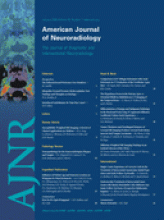Abstract
BACKGROUND AND PURPOSE: Many theories of normal pressure hydrocephalus (NPH) stress the importance of ischemia in the deep white matter. Alternate theories stress a reduction in superficial venous compliance and changes in pulse-wave propagation. An overlap in the cerebral blood flow volumes measured between NPH and controls suggests that ischemia may not be a prerequisite for this condition. This study sought to compare blood flow and compliance measures in a cohort of patients with NPH selected for having arterial inflows above the normal range to see if deep brain ischemia or superficial hemodynamic changes contribute to the pathophysiology of NPH.
MATERIALS AND METHODS: Twenty patients with NPH and arterial inflows above the normal range were selected. They underwent MR imaging with flow quantification measuring the total blood inflow, sagittal/straight sinus outflow, aqueduct stroke volume, and arteriovenous delay (AVD). Patients were compared with 12 age-matched controls.
RESULTS: The deep outflow volumes were normal. The superficial venous outflow was reduced as a percentage of the inflow by 9% (P = .04). The sagittal sinus compliance as measured by the AVD was reduced by 50% (P = .0001), and the aqueduct stroke volume was elevated by 192% (P = .02).
CONCLUSION: Ischemia in the deep venous territory is not a prerequisite for NPH. Patients with high-inflow NPH show alterations in superficial venous compliance and a reduction in the blood flow returning via the sagittal sinus. These changes together suggest that an elevation in superficial venous pressure may occur in NPH.
- Copyright © American Society of Neuroradiology












